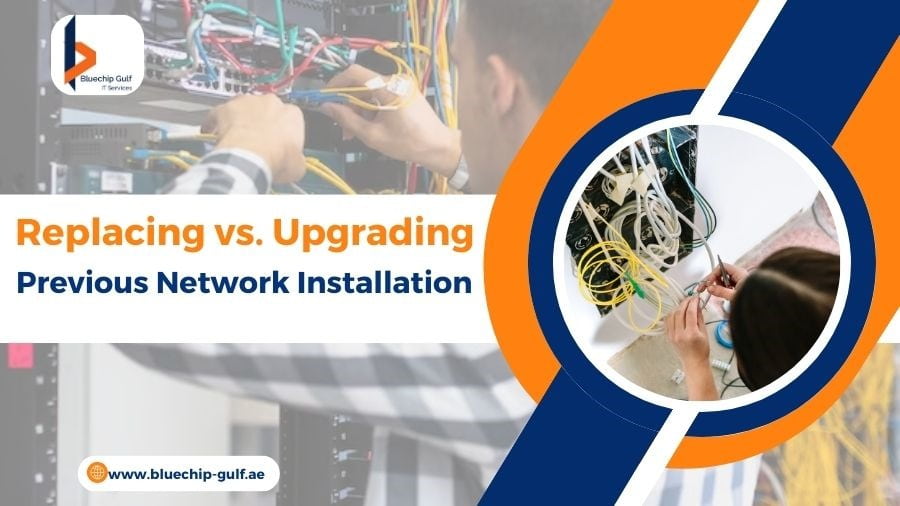
Communicate, and Conduct Operations Efficiently. However, as Technology Evolves, So Do the Orders Set on Your Network. Over Time, You May Find Yourself Facing the Decision of Whether to Replace or Upgrade Your Existing Network Installation. This Decision Can Significantly Impact Your Organization’s Performance, Security, and Cost Efficiency. In This Blog, We’ll Explore the Factors to Consider When Making This Critical Choice.
Understanding the Difference: Replacement vs. Upgrade
Before delving into the factors that influence your decision, it’s essential to clarify the difference between replacing and upgrading a network installation –
- Network Replacement – This involves removing the existing network infrastructure entirely and installing a brand-new system from the ground up. It typically includes replacing all hardware, cables, switches, routers, and servers.
- 2. Network Upgrade – An upgrade entails making improvements or enhancements to the existing network infrastructure while retaining some or all of the current components. This may involve replacing certain components, expanding capacity, or updating software and firmware.
Explore the Factors to Consider When Deciding Between Replace and Upgrade
- Age and Obsolescence of Hardware
One of the major aspects of this decision is the age and condition of your existing hardware. Network components, such as routers, switches, and servers, have a finite lifespan. Outdated hardware may struggle to keep up with the demands of modern applications, leading to performance issues and security vulnerabilities.
Upgrade – If your hardware is relatively new and can be updated with firmware or software enhancements, an upgrade may be a cost-effective solution. However, if your hardware is significantly outdated and incompatible with the latest technologies, replacement is likely the better choice.
- Performance Requirements
Consider your organization’s current and future performance needs. If your network is consistently slow, experiences downtime, or struggles to handle increased traffic, it’s essential to address these performance issues.
Upgrade – If your network’s performance issues are primarily due to outdated hardware or limited capacity, upgrading specific components, such as routers or switches, can improve performance and efficiency.
- Scalability
The ability to scale your network to accommodate growing demands is crucial for long-term success. Evaluate whether your existing network infrastructure can support future growth and additional users or devices.
Upgrade – If your network is already designed with scalability in mind, you may only need to add new components or expand capacity to accommodate growth. However, if your current network lacks scalability features, a replacement may be necessary to ensure future expansion is feasible.
- Security Considerations
Security is paramount for any association, and network vulnerabilities can be exploited by cyber threats. Outdated hardware and software may shortage of basic protection features, putting your data at risk.
Upgrade – If your existing hardware can support the latest security updates and features, an upgrade may enhance your network’s security posture. However, if your hardware is no longer receiving security updates or is susceptible to vulnerabilities, a replacement may be the only viable option to ensure robust protection.
- Cost and Budget Constraints
Budget concerns play a noteworthy part in this decision. Replacing an entire network can be a substantial investment, whereas upgrades may offer a more budget-friendly option.
Upgrade – Upgrading specific components can be a cost-effective solution, especially if your budget is limited. Prioritize upgrades that address critical performance and security issues.
- Future Technology Trends
Evaluate the order in which technology is progressing. Emerging technologies, such as 5G, Internet of Things (IoT), and cloud computing, may require network enhancements to support new requirements.
Upgrade – If your network infrastructure is well-positioned to adapt to emerging technologies through upgrades, you can stay ahead of the curve without the need for a complete replacement.
- Environmental Impact
Sustainability and environmental impact are increasingly important considerations for businesses. Replacing older, energy-inefficient hardware with newer, more eco-friendly alternatives can reduce your organization’s carbon footprint.
Upgrade – If your existing network infrastructure can be upgraded with energy-efficient components, it may align better with sustainability goals than a full replacement.
- Downtime and Disruption
Decreasing downtime and disturbance to your business functions is critical. Think how long it will take to execute either an upgrade or a replacement.
Upgrade – Upgrading specific components may require less downtime and disruption compared to a full network replacement, making it a more attractive option for businesses with stringent uptime requirements.
- Expertise and Support
Assess whether your IT team possesses the necessary expertise to execute upgrades or whether you require external support for either option.
Upgrade – Upgrading existing components may be more straightforward if your team is familiar with the current infrastructure. However, for complex upgrades or if you lack in-house expertise, seeking professional assistance is advisable.
Ultimately, the decision to replace or upgrade your network installation depends on a combination of factors, including the age of your hardware, performance requirements, scalability needs, security considerations, budget constraints, and future technology trends. It’s essential to strike the right balance between improving your network’s capabilities and minimizing disruption to your business operations.
In many cases, a well-planned network upgrade can effectively address performance and security concerns while keeping costs in check. However, if your existing infrastructure is outdated, lacks essential features, or hinders scalability, a complete network replacement may be the best long-term solution. Consult with IT experts and conduct a thorough assessment of your network to make a knowledgeable judgment that aligns with your association’s objectives and priorities.
Also Read: Crafting a Robust Business-Continuity Strategy: Key Steps and Best Practices

